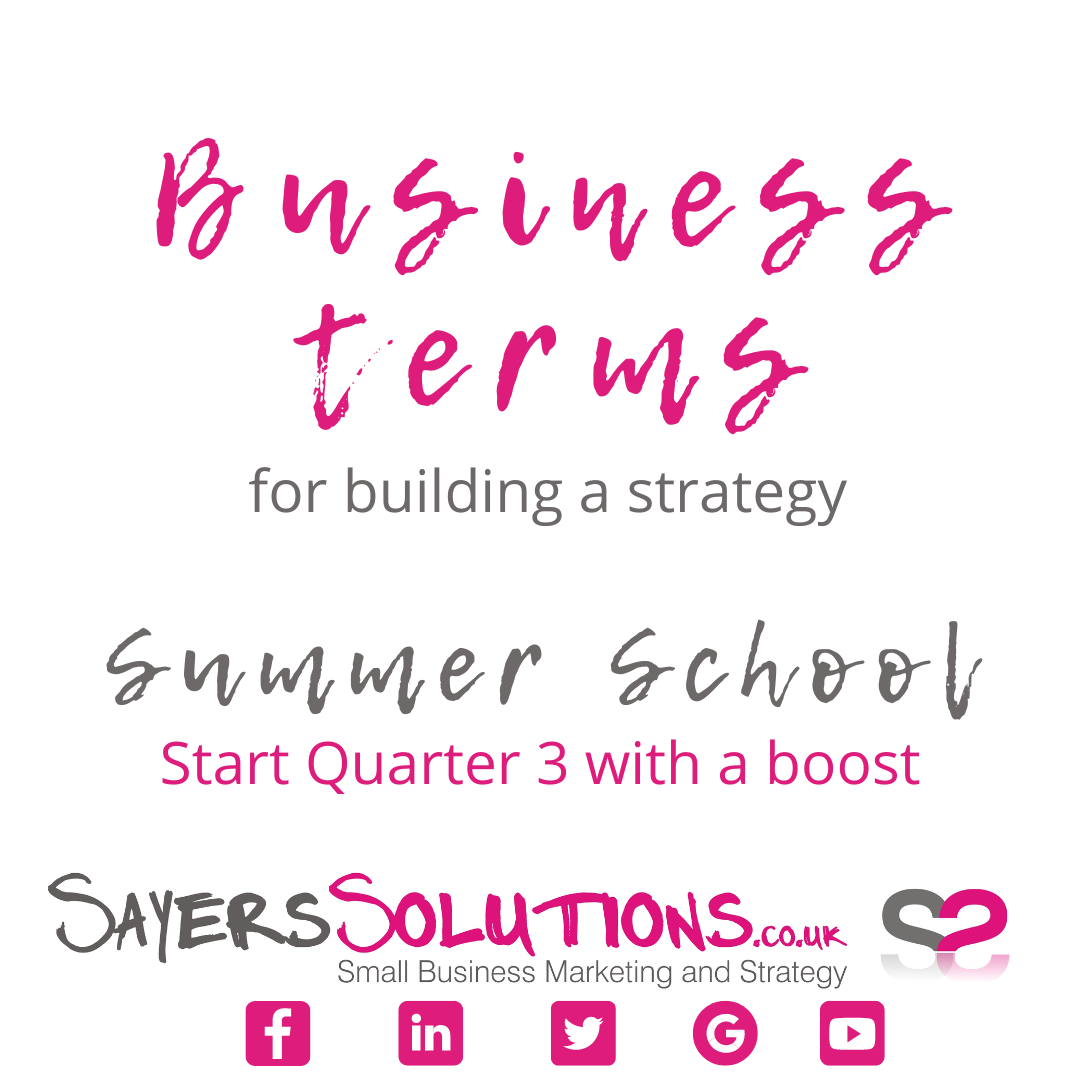Business Terms
Sayers Solutions’ Summer School
The first session of Summer School aims to provide you with explanations of some business terms which Sayers Solutions use with clients to help them explore their business and build a strategy for it.
Work through these, as with the rest of the course, to understand what the terms mean and how they apply to your organisation, and strategy.
Visit our printable at the bottom of this page, which gives you a template for your notes.
Strategy
A strategy is simply a plan. To do anything, there needs to be an element of planning. When you perform actions frequently enough you might feel like you don’t need to refer to one. But, to change direction or make improvements a plan needs to be created.
A strategy can be a way of looking into the future. It can provide direction and scope for an organisation over the long-term. Whilst setting out want needs to be achieved to create advantage for the organisation, through its configuration of resources, within a challenging environment, to meet the needs of markets and to fulfil stakeholder expectations.
By creating a strategy, you outline a plan of action to be executed, which drives the organisation in the desired direction.
Business Definition
The business definition is the starting and finishing point of strategic planning.
It establishes what the business is and where it is heading.
There is a certain amount of un-blinkered creativity involved with strategic marketing thinking.
It is most successful when the marketer thinks not in terms of product, but rather in terms of benefits or solutions delivered to the customer.
There are three business definition scopes –
- narrow scope – product based
- intermediate scope – industry based
- broad scope – customer needs/ benefit based
Ask yourself the question, “What business are you in? “
Try to avoid being too focused on the product, instead focus on identification of the customer needs.
Use creative, outward-looking, problem-solving marketing thinking.
Customers buy products to solve problems,
if the product does not solve the problem or if something else solves it better,
then the customer will turn away.
The distinction between the product and the problem it solves matters because marketing strategy is about managing the organisation’s activities within the real world.
So instead, maybe think “What problem does your business solve?”
Vision
Each organisation will have a vision of who they want to be, what they want to do and how they think they will do it, even if it has not been established or documented.
Your vision sets the purpose, general direction, and the path of the organisation. It is the desired future state of the organisation, and an aspiration around which to focus attention and energies.
Ask yourself these questions –
- How do you see your business in three / five / ten years’ time?
- What do you want people to be saying about your business then?
- E.g. – customers, suppliers, competitors, peers, family members etc
Vision Statement
Your vison statement is the future state of the business. By documenting your vision, you can create a strategy.
While it is ever changing in your mind, any plans you make will not be effective. By documenting your vision, you can focus on how you will get there, as well as measure your success and journey.
Values
Values are the understandings and expectations of the organisation, upon which all organisational relationships are based.
Mission Statement
The mission statement is a generalised statement about the purpose of the organisation. It is the reason your business exists.
To be useful to you it needs to be relevant, memorable, and inspirational.
Your Vision provides an overall frame of reference within which a mission statement is written, and goals are selected.
“If vision is ill formed, mission statements will be vague
and goal achievement hard to measure”.
Goals and Objectives
All businesses need goals to measure success and set direction. If you do not know where you are going, how will you know when you arrive?
Very broadly, organizational goals can be classified into a few categories:
- Those that aim to make a profit for their owners.
- Those that aim to maximize benefits to society.
- Those that aim to maximize benefits to their members.
What do you want to achieve?
Macro and Microenvironments
You need to be aware of both everything your organisation is and what you can control, as well as what you cannot. The external influences that could impact your business are your macro environment, whereas the internal factors are your microenvironment.
Assets and Competencies
Assets and competencies often provide a sustainable competitive advantage (SCA).
- A competency is what an organisation does exceptionally well.
- An asset is a resource.
Formulation of your strategy must consider the cost and feasibility of generating and maintaining assets and competencies, that will provide the basis for a sustainable competitive advantage.
Core Competencies
Core competencies are the special and unique capabilities that distinguish the organisation from its competitors and critically underpin the organisation’s competitive advantage.
Target Audience / Market
Target audience or target markets are a defined group of consumers (whether defined by demographic, geography, user types, customer stages) to segment your market of potential buyers.
Value Proposition
A value proposition summarizes why a customer would choose your product or service.
It needs to appeal to new and existing customers, be relevant and meaningful and reflect the positioning of the product or service.
It also needs to be sustainable over time and make the business stand out from its competitors.

